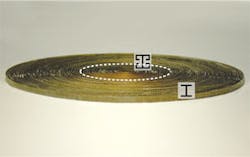Metamaterial inventor Sir John Pendry awarded the Julius Springer Prize for Applied Physics 2013
Berlin, Germany--This year’s Julius Springer Prize for Applied Physics will be awarded to Sir John Pendry, whose work on metamaterials has opened the doors to a wide range of new possibilities in photonics and applied physics. The award, accompanied by (what seems a relatively small amount of) US$ 5000, will be presented on 18 October 2013 at the Magnus Haus of the German Physical Society in Berlin.
Pendry received his Ph.D. from the University of Cambridge in 1969 and worked at Bell Laboratories from 1972-1973. He has held his professorship in the Blackett Laboratory (Imperial College, London) since 1981. In 1998 he became the head of the Physics Department and is currently the Chair in Theoretical Solid State Physics. He was knighted (Knight Bachelor) in 2004 by Queen Elizabeth II and was named a Fellow of the Optical Society of America in 2005.
Invention of optical metamaterials
Pendry pioneered optical metamaterials, which are ordered subwavelength structures often with both dielectric and metal components; metamaterials can be fashioned into previously impossible optical devices such as so-called perfect lenses and other devices using negative refraction, cloaks, and so on. In the 1990s, Pendry developed methods to calculate the performance of these structures (for example, see http://www.tandfonline.com/doi/abs/10.1080/09500349414550281).
The properties of metamaterials are complex enough that they sometimes elude mass-media popular science journalists, who often uncritically link metamaterial cloaking to the invisibility cloak described in the Harry Potter book series; in truth, an optical metamaterial cloak large enough to hide a person may not be achievable practically, due to the fact that such a structure, containing perhaps trillions of unit cells, would have to be made to deep-subwavelength perfection and held rigid to the same tolerances; absorption, narrowband wavelength properties, and other problems also prevent such an idea from being seen (or more precisely, not seen) on the streets.
Despite this, metamaterials are a true revolution. When done on a smaller scale (a few millimeters or less for visible light, although easily to far larger scales for microwave radiation), they allow the designer seemingly to warp space itself, at least as it is seen by electromagnetic radiation. This warping of "space" can be so extreme as to produce an electromagnetic "black hole."
The Julius Springer Prize for Applied Physics recognizes researchers who have made an outstanding and innovative contribution to the field of applied physics. It has been awarded annually since 1998 by the editors-in-chief of the Springer journals Applied Physics A – Materials Science & Processing and Applied Physics B – Lasers and Optics.
The award will be presented on 18 October 2013 at 6:30 pm at the Magnus Haus der DGP, Am Kupfergraben 7, in Berlin, Germany. Sir John Pendry will give a lecture on “Metamaterials: New Horizons in Electromagnetism.”

John Wallace | Senior Technical Editor (1998-2022)
John Wallace was with Laser Focus World for nearly 25 years, retiring in late June 2022. He obtained a bachelor's degree in mechanical engineering and physics at Rutgers University and a master's in optical engineering at the University of Rochester. Before becoming an editor, John worked as an engineer at RCA, Exxon, Eastman Kodak, and GCA Corporation.
